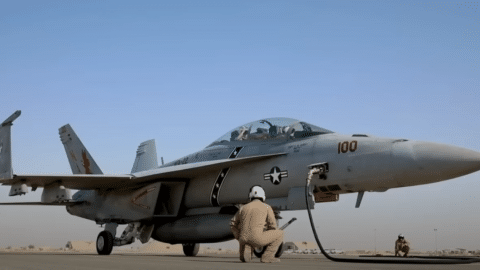
YouTube / The Ready Room
Gonky, the host of The Ready Room and a US fighter pilot, tells us five things we didn’t know about the F/A-18 Hornet according to his experiences:
“As a new guy, I went out there and decided I want to see how fast this thing will go.”

He went up to 40,000 ft and tried to get as fast as possible in level flight. He rolled over on his back, pulled the nose down, and was surprised that the F-18 actually slowed down. He remembers going at Mach 1.2 but never faster than that when he was pointing down, even with a full afterburner.
F-18As through F-18Ds can apparently supercruise! Even with the centerline tank, two pylons, and missiles on the wingtips, the F-18 can supercruise around Mach 1.03/1.04.

“You won’t go very supersonic, and I’m confident the Raptor can supercruise much better.”
If you’re at least in the 20s or higher altitudes and you could make an unrestricted descent (no level-offs on the way down), you can make about 500 lbs of gas. They do this by bringing the throttles to IDLE so the Variable Exhaust Nozzle (nozzle at the end of the engines) would open all the way.

As soon as the VENs would close, which is just a hair-off IDLE, you get a lot more thrust because it’s trying to shove air through a much smaller hole at IDLE thrust. ‘Puckering the nozzles,’ as they would call it, is essential to carrier operations.
“In theory, it’s kind of like free thrust. IDLE power with more thrust, if you will”
In the early 2000s, they had an aviator come talk to them as part of his punishment for attempting a takeoff in the X-wing configuration. According to the aviator’s story, he was on deployment and got diverted into Bagram.

The aviator had to fold his wings to fit into the field pits he got his gas at and was in a hurry to get back to make the recovery time of the ship. He then tried to take off with his wings folded, which his wingman swiftly called him out for. Afterward, he did a high-speed abort, resulting in the F-18’s breaks catching fire and accumulating damages.
“At about 200 knots, he said the airplane rotated and was going flying. Two hundred knots is well beyond the rotation speed and even flying speed of the F-18, especially on the ground.”
Would it have flown? Could it have been controllable? It’s all up for debate.
The Hornet is all digital, so if you want to roll faster, push the stick to the left or right further. If you’re going to climb, pull back on the stick. When doing any dynamic maneuvers, you can see the leading edge flaps, trailing edge flaps, and ailerons all doing their own thing.

“If you the plane with the mentality of conventional flight controls, you get yourself in trouble.”